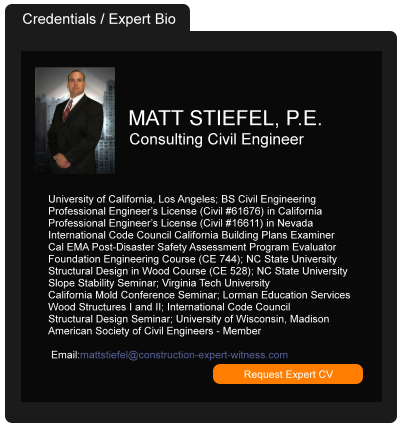California Contractor Tests the Bounds of Job Order Contracting
March 01, 2021 —
Garret Murai - California Construction Law BlogMost contractors have heard of design-bid-build, design-build, construction manager at risk, and even public private partnerships, various project delivery methods, which, at their heart, focus on balancing the interests of the various parties involved in a construction project, from owners, to design professionals, to contractors. There’s one project delivery method you may not be as familiar with though: Job Order Contracting, also known by its acronym JOC.
JOC contracting is a project delivery method used on public works projects and has been authorized to be used by California K-12 school districts, community colleges, CalState universities, and the Judicial Council of California, which, among other things, is responsible for the construction of California state courts. It is intended to be used on smaller, independent, long-horizon project typically involving maintenance, repair and refurbishment. Think periodic maintenance of facilities.
JOC contracts are administered by public entities issuing a request for proposals. The public entity then awards a JOC contract to the lowest responsible bidder. The lowest responsible bidder then enters into a JOC contract with the public entity. JOC contracts typically have a duration of one (1) year and are limited to a total construction value of $4.9 million increased annually based on the Consumer Price Index. When entering into a JOC contract, a JOC contractor agrees to perform work at prices set forth in a Construction Task Catalog also known as a unit price book which includes current local labor, material and equipment costs. Unit prices are then adjusted by a “bid adjustment factor” based on the JOC contractor’s bid. When work is needed, the public entity will then issue a job order to the JOC contractor.
Read the court decisionRead the full story...Reprinted courtesy of
Garret Murai, Nomos LLPMr. Murai may be contacted at
gmurai@nomosllp.com
Los Angeles Wildfires to Impact Profitability of US Property Insurers, Says GlobalData
February 03, 2025 —
GlobalDataThe Los Angeles (LA) area in the US has witnessed a devastating impact from a series of wildfires that erupted since the second week of January. There were 312 wildfires that resulted in 28 deaths and the destruction of 16,255 structures as of 29 January, with the Palisades and Eaton wildfires continuing to burn, according to the California Department of Forestry and Fire Protection. Estimates from the University of California suggest that the total damage from the LA wildfires could surpass $20 billion. Consequently, US insurers may see increased claims in 2025 across various insurance lines, potentially affecting their profitability, says
GlobalData, a leading data and analytics company.
Manogna Vangari,
Insurance Analyst at GlobalData, comments: "The recent LA wildfires are expected to impose significant financial burdens on property and casualty insurers, with damages potentially exceeding billions of dollars. The destruction affects both residential and commercial properties, particularly high-value homes and businesses, leading to anticipated insured losses to be among the highest in California's history."
Property insurance claims are projected to represent a 13.1% share of total general insurance claims in the US in 2025, totaling $247 billion. Incurred losses are anticipated to rise by 7.5% in 2025, reaching $193.6 billion from $180.1 billion in 2024. However, the full effect of wildfires may push actual claims even higher. Consequently, the profitability of the US general insurance sector is expected to be notably affected, with the average combined ratio predicted to exceed 100% in 2025.
According to GlobalData's
Global Insurance Database, the US property insurance industry is expected to grow at a CAGR of 7.3% over 2025–29, from $416.3 billion in 2025 to $551.1 billion in 2029, in terms of gross written premiums (GWP).
Read the court decisionRead the full story...Reprinted courtesy of
Previously Owned U.S. Home Sales Rise to Eight-Month High
July 23, 2014 —
Victoria Stilwell – BloombergSales (ETSLTOTL) of previously owned U.S. homes climbed in June to an eight-month high as more listings helped prices cool, luring buyers into the market.
Sales increased 2.6 percent to a 5.04 million annual rate last month, led by gains in all four U.S. regions, figures from the National Association of Realtors showed today in Washington. The median forecast of 78 economists surveyed by Bloomberg projected sales would rise to a 4.99 million rate. Prices advanced at the slowest pace since March 2012 and inventories rose to an almost two-year high.
Historically low interest rates and smaller price increases are helping bring homeownership within reach for more Americans. A pickup in employment opportunities that lead to faster wage growth would provide an added spark for a residential real-estate market that began to soften in the middle of 2013.
Read the court decisionRead the full story...Reprinted courtesy of
Victoria Stilwell, BloombergMs. Stilwell may be contacted at
vstilwell1@bloomberg.net
Settlement Reached in Bridge Failure Lawsuit
December 11, 2013 —
CDJ STAFFOfficials claimed the failure of a bridge in Afton Township, Illinois was because trucks owned by Welded Construction used the bridge despite exceeding the bridge’s weight limit of 36.5 tons. The firm argued that they should be responsible for the depreciated cost of the bridge, not its replacement cost. Welded Construction had been using the bridge to get to the site of an oil pipeline construction project for Enbridge Energy.
Replacement of the bridge was initially estimated at $933,000, but that was in advance of any design work. Enbridge Energy settled the case at $900,000, which should cover most or all of the cost of repair or replacement. Some federal funds may also be available for repairing or constructing a new bridge.
Read the court decisionRead the full story...Reprinted courtesy of
Collapse of Breezeway Attached to Building Covered
February 24, 2020 —
Tred R. Eyerly - Insurance Law HawaiiThe federal district court found that a breezeway that collapsed during a party was covered by the commercial property policy. DENC, LLC v. Philadelphia Indem. Ins. Co., 2019 U.S. Dist. LEXIS 179083 (M.D. N.C. Oct. 15, 2019).
DENC owned an apartment complex that was insured by Philadelphia under an all-risk policy. During an early morning party, a large number of students gathered on the second-floor breezeway for a party. The students started jumping in the breezeway when a certain song started playing. The floor abruptly collapsed underneath the students.
Philadelphia sent an adjuster to inspect the breezeway a couple days later. He wrote to Philadelphia that "the sole and proximate cause of the loss is water damage occurring over an extended period of time causing the second floor breezeway to sage and the light weight concrete to crack." Shortly thereafter, the building was condemned. A structural engineer found multiple ways in which water had seeped into the breezeway's wood framing and photographed the resulting biological growth and wood decay. He concluded that the building had sustained significant long-term water intrusion which resulted in the wood framing inability to support the loads. The water intrusion was caused by the failure to properly install a water management system on the walls, a properly integrated waterproof system for the walkway slab and framing configuration, and improper venting of dryers.
DENC retained an engineer who testified that the breezeway was sagging because the concrete had broken.
Read the court decisionRead the full story...Reprinted courtesy of
Tred R. Eyerly, Damon Key Leong Kupchak HastertMr. Eyerly may be contacted at
te@hawaiilawyer.com
OSHA Extends Temporary Fall Protection Rules
March 01, 2012 —
CDJ STAFFOSHA announced that its current rules on fall protection for residential construction will remain in place until September 15, 2012. The current measures became effective in June 2011. Under the new rules, falls must be prevented by fall protection measures unless the measures can be shown to be unfeasible or even hazardous.
�Under the extension of the temporary enforcement measures, contractors who ask for compliance assistance with OSHA are given top priority and penalties can be reduced. OSHA has conducted more than 1,000 outreach sessions on the new rules.
Read the full story…
Read the court decisionRead the full story...Reprinted courtesy of
Differing Rulings On Construction Defect Claims Leave Unanswered Questions For Builders, and Construction Practice Groups. Impact to CGL Carriers, General Contractors, Builders Remains Unclear
March 07, 2011 —
CDJ STAFFIn the past year a number of state and federal courts have rendered a number of conflicting decisions that promise to alter or perhaps shift entirely the paradigm, of how builders manage risk.
�According to a report today by Dave Lenckus in Property Casualty 360 “Nine state and federal courts and one state legislature over the past year have addressed whether a construction defect a defective product or faulty workmanship is fortuitous and therefore an occurrence under the commercial general liability insurance policy. Four jurisdictions determined it is; three said no; two ruled that a construction defect that causes consequential damage to property other than the work product is an occurrence; and one federal court contributed its conflicting case law that has developed in Oregon since its high court ruled in 2000 that a construction defect is not an occurrence”.
�The article strongly suggests that in the absence of a clear consensus over what the recent rulings mean for builders and contractors coverage disputes will intensify and continue to proliferate.
� Doing this on a state-by-state basis has caused a lot of confusion among buyers and sellers, said Jeffrey A. Segall, a Tampa-based senior vice president and the Florida Construction Practice leader at Willis of Florida, a unit of Willis Group Holdings.
�Read Full Story...
Read the court decisionRead the full story...Reprinted courtesy of
Handshake Deals Gone Wrong
May 22, 2023 —
Jessica Allain - ConsensusDocsThe construction industry has it fair share of “handshake deals”, oral agreements relying on the integrity of the people involved. But when it comes to protecting and enforcing legal rights, it is always a better idea to properly paper the deal and get it in writing. Otherwise, contractors relying on verbal promises may find themselves without any legal remedy should the deal go south. After all, it is not just a matter of trust, but also a way to document that everybody agrees on what the terms of the deal actually are.
For example, a recent case out of New York highlights the dangers of unwritten promises. In Castle Restoration, LLC v. Castle Restoration & Construction, Inc., No. 16349-15 (N.Y. App. Div. 2/9/22), 2022 NY Slip Op 50082(U), 2022 WL 402882, 2022 N.Y. Misc. LEXIS 485, Castle Inc. and Castle LLC entered into a deal for an asset sale to transfer equipment and a client list from Castle Inc. to Castle LLC. While that initial asset sale was properly papered with sale documents and a promissory note, the parties entered into a subsequent handshake/oral agreement where Castle LLC agreed to provide Castle Inc. with labor and materials on construction projects, and those goods and services would offset the payment obligation under the promissory note. But the problem was that the contract for the asset sale had a provision that the agreement could not be changed by oral agreement; rather, any changes had to be made in writing.
Reprinted courtesy of
Jessica Allain, Jones Walker LLP (ConsensusDocs)
Ms. Allain may be contacted at jallain@joneswalker.com
Read the court decisionRead the full story...Reprinted courtesy of


































































